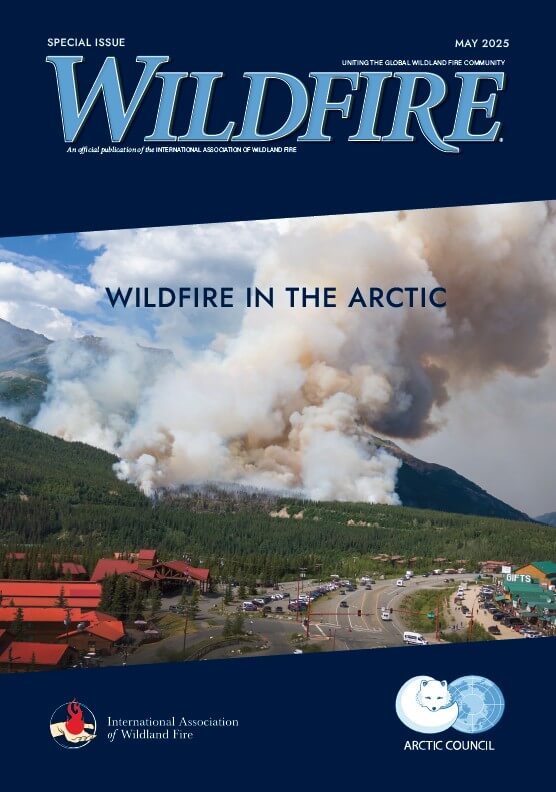IAWF members have free online access to all research articles and back issues, a great member benefit. The IAWF member page directs you to the Journal, where you can search for your paper, author and/or fire subject of interest. All papers that have been accepted, even those not yet published in hard copy, can be found on the site.
The eleventh issue of the International Journal of Wildland Fire in 2016, Volume 25(11) 2016, contains the following papers:
Spatial and temporal variations of fire regimes in the Canadian Rocky Mountains and Foothills of southern Alberta
Marie-Pierre Rogeau, Mike D. Flannigan, Brad C. Hawkes, Marc-André Parisien and Rick Arthur
Distinct historical fire regimes with evidence of an anthropogenic influence exist between the Subalpine, Montane and Upper Foothills of southern Alberta. Post-1948 median fire return intervals have departed by up to 223% in the Montane and Foothills, while the Subalpine had a 42% departure in the most rugged region
Anthropogenic influence on wildfire activity in Alberta, Canada
François-Nicolas Robinne, Marc-André Parisien and Mike Flannigan
We investigated the effect of human development on the area burned in Alberta over a 31-year period. We tested the importance of several human factors. Our results point to a possible ‘ecological frontier’ in which human ignitions increase landscape fire susceptibility in areas where recent industrial expansion and forested wildlands overlap.
Recovery and adaptation after wildfire on the Colorado Front Range (2010–12)
Miranda H. Mockrin, Susan I. Stewart, Volker C. Radeloff and Roger B. Hammer
Time after wildfire is often discussed as an opportunity for policy change and adaptation, where new regulations and rebuilding can transform the wildland–urban interface, reducing future risk. Our study of recovery post-fire in Colorado found some evidence of adaptation, but also extensive reinvestment in hazard-prone environments, supported by local governments.
Spatial variability of surface fuels in treated and untreated ponderosa pine forests of the southern Rocky Mountains
Emma Vakili, Chad M. Hoffman, Robert E. Keane, Wade T. Tinkham and Yvette Dickinson
Fuel component semivariance increased with particle diameter regardless of stand condition, with stand-level fuel component loading providing strong predictions (R2 = 0.99). Spatial scales of autocorrelation followed closely (R2 = 0.88) with fuel particle diameter. Incorporating spatial knowledge into fuel sampling will improve fire modelling and wildlife habitat assessments over singular stand-level means.
Near-term probabilistic forecast of significant wildfire events for the Western United States
Haiganoush K. Preisler, Karin L. Riley, Crystal S. Stonesifer, Dave E. Calkin and W. Matthew Jolly
We present a probabilistic model for forecasting expected number of significant wildfire events for the upcoming week for the Western United States. The procedure may be used to provide daily maps of fire risk with expected number and quantiles of significant fires in each risk category
Faster prediction of wildfire behaviour by physical models through application of proper orthogonal decomposition
Elisa Guelpa, Adriano Sciacovelli, Vittorio Verda and Davide Ascoli
In this paper, proper orthogonal decomposition is applied for the first time to the prediction of fire evolution by physical modelling. The paper shows how this reduction method is able to dramatically reduce the computational cost of physical models without causing the loss of important information.
Visual assessments of fuel loads are poorly related to destructively sampled fuel loads in eucalypt forests
Liubov Volkova, Andrew L. Sullivan, Stephen H. Roxburgh and Christopher J. Weston
Visual assessment of forest fuels is often used to estimate fuel load and predict fire behaviour. More than 500 visual assessments were compared against destructively sampled fuel loads, showing poor correlation between the two and highlighting several serious deficiencies in the operational fuel hazard assessment process.
Soil heating during the complete combustion of mega-logs and broadcast burning in central Oregon USA pumice soils
Jane E. Smith, Ariel D. Cowan and Stephen A. Fitzgerald
Extreme soil heating is a concern to forest managers. Temperatures lethal to fine roots and soil organisms were measured beneath combusted mega-logs to at least 10 cm for about 7 hours. Soils in a broadcast burn of masticated fuels experienced lethal temperatures in most cases only at the surface for about an hour.
